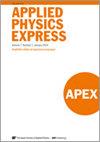通过将电极尺寸减小到 ϕ2.2 μm 提高红色纳米柱 μ-LED 的发光效率
IF 2.2
4区 物理与天体物理
Q3 PHYSICS, APPLIED
引用次数: 0
摘要
基于 InGaN 的红色纳米柱微型 μLED 的发射直径为 ϕ2.2 μm,在峰值波长 615 nm 处的片上外部量子效率 (EQE) 达到 2.1%。通过在相同的纳米柱图案区域重复电极工艺,并将发射直径从 ϕ80 减小到 ϕ2.2 μm,制造出了这种 LED。当发射直径从 1.2% 减小到 2.1% 时,峰值 EQE 在 25 A cm-2 时达到最大值。这种行为不同于 InGaN 薄膜发光二极管,其特点是纳米柱发光二极管侧壁钝化的独立纳米发光二极管单元。本文章由计算机程序翻译,如有差异,请以英文原文为准。
Improving the luminous efficiency of red nanocolumn μ-LEDs by reducing electrode size to ϕ2.2 μm
A red InGaN-based nanocolumn micro μLED with an emission diameter of ϕ2.2 μm was demonstrated to achieve an on-wafer external quantum efficiency (EQE) of 2.1% at the peak wavelength of 615 nm. The LED was fabricated by repeating the electrode process on the same nanocolumn pattern area and reducing the emission diameter from ϕ80 to ϕ2.2 μm. The peak EQE, which was maximized at ∼25 A cm−2, increased by decreasing the emission diameter from 1.2% to 2.1%. This behavior, which differs from that of InGaN-film LEDs, is characterized as a unit of independent nano-LEDs with passivated sidewalls of nanocolumn LEDs.
求助全文
通过发布文献求助,成功后即可免费获取论文全文。
去求助
来源期刊

Applied Physics Express
物理-物理:应用
CiteScore
4.80
自引率
8.70%
发文量
310
审稿时长
1.2 months
期刊介绍:
Applied Physics Express (APEX) is a letters journal devoted solely to rapid dissemination of up-to-date and concise reports on new findings in applied physics. The motto of APEX is high scientific quality and prompt publication. APEX is a sister journal of the Japanese Journal of Applied Physics (JJAP) and is published by IOP Publishing Ltd on behalf of the Japan Society of Applied Physics (JSAP).
 求助内容:
求助内容: 应助结果提醒方式:
应助结果提醒方式:


